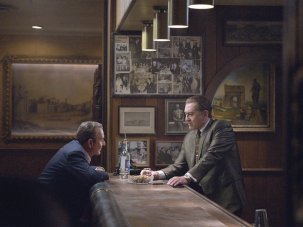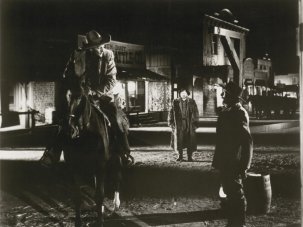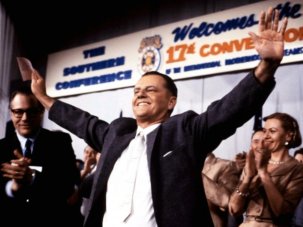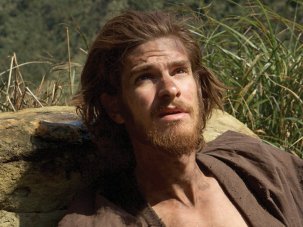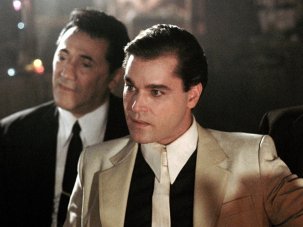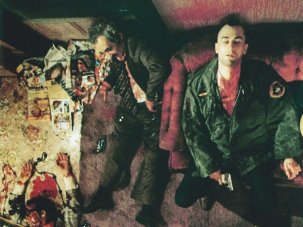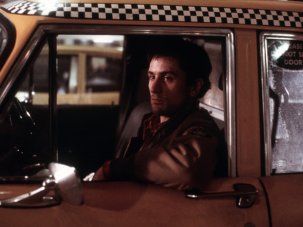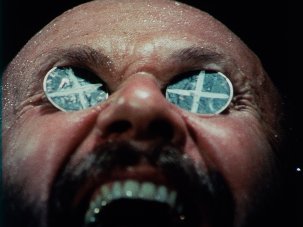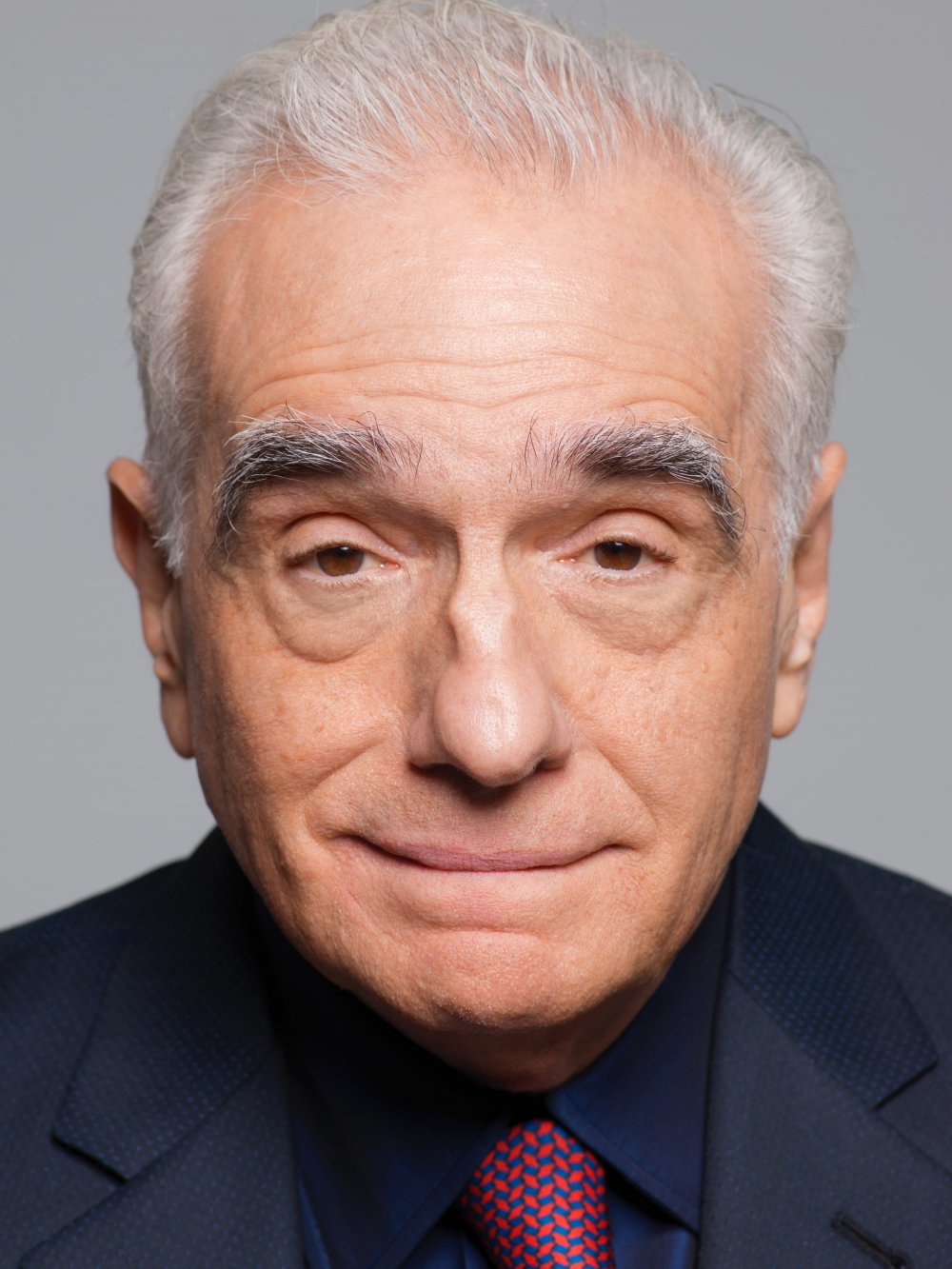
Martin Scorsese
Credit: Brigitte Lacombe
Well, what can I tell you?” began Martin Scorsese, when I spoke to him in New York a month before the British premiere of his latest film The Irishman at the BFI London Film Festival. “I’ve nothing to say!” But then he laughed, and we talked for three and a half hours – slightly more, in fact, than the duration of the film.
The Irishman is in select cinemas and streaming on Netflix.
We met one warm afternoon in a comfortable Midtown hotel suite that he uses as a quiet venue for scriptwriting and for meetings. He had been working on the script of his next film, Killers of the Flower Moon, to star Robert De Niro and Leonardo DiCaprio, as well as other projects; and to begin with was visibly weary, as a man half his age might have been under such pressure.
After the agonies and spiritual torment of Silence (2016), the grand, dark epic The Irishman, running to three hours and 20 minutes, puts us back in more familiar Scorsese territory – in the world of Italian-American gangsters, and after a five-film partnership with DiCaprio, back with De Niro, their ninth film together and the first since Casino (1995).
The movie, based on Charles Brandt’s true-crime book I Heard You Paint Houses (2004), tells the story of Frank Sheeran (De Niro), the Irishman of the title, from his 411 days of combat in World War II, tasked with ‘handling’ – aka murdering – prisoners-of-war in General George Patton’s ‘Killer’ 45th Infantry Division, through to his recruitment as a handler of ‘matters’ by Mafia bosses Russell Bufalino (Joe Pesci) and Angelo Bruno (Harvey Keitel). It tracks his progress out of a life of hustling and post-war petty crime to his close but Mafia-sponsored friendship with Jimmy Hoffa (Al Pacino), the tough, charismatic, now unimaginably powerful boss of America’s biggest labour union, the International Brotherhood of Teamsters, whose disappearance in a Detroit suburb on 30 July 1975 has never been definitively solved. In fact, it takes us further, beyond all that.
It might have all seemed too late: Scorsese is 76, De Niro 75, Keitel 80, Pacino 79 – and Pesci, 75, had to be coaxed out of retirement. But director and actors are still in sprightly, and magnificent, form. Pesci, De Niro and Pacino, the central grouping here, are quite spellbinding. In particular, it’s De Niro’s best performance for years, quiet but immensely subtle and cumulatively very moving, brutal but also confused and vulnerable.
Pesci is as terrifying as in GoodFellas (1990), but in a wholly new mode, his violent ruthlessness veiled by his mild, avuncular manner. And while Pacino’s extrovert Hoffa gives grandstanding speeches, and his fiery outbursts are spectacular, there’s a core of tenderness in his relationship with Frank that heightens the tragedy.
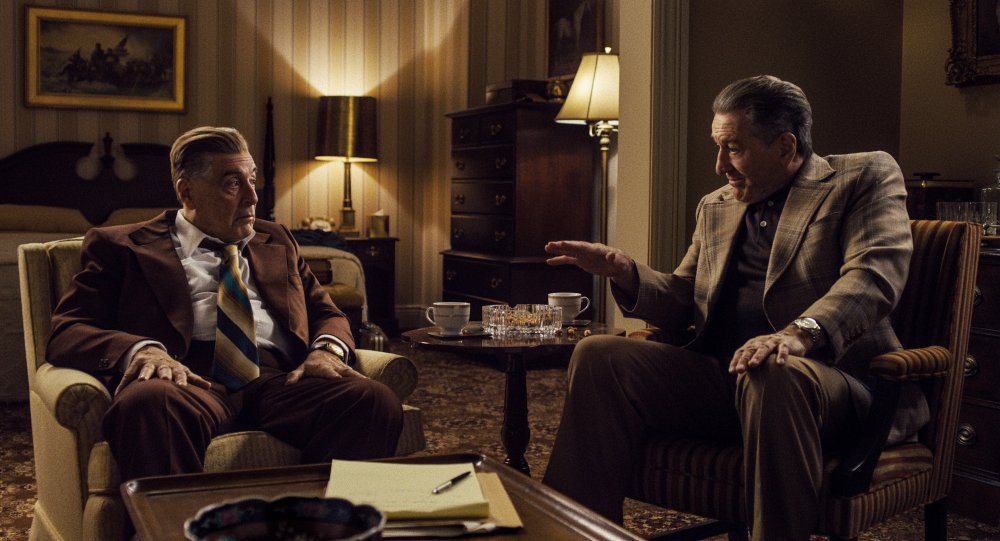
The Irishman (2019)
The film was made possible by a refined CGI process painstakingly developed by Pablo Helman of Industrial Light & Magic, called ‘youthification’ by Scorsese, which de-ages the actors while retaining the nuances of their performances – allowing De Niro for one brief scene to go back even as far as World War II, when Sheeran was 24, but mostly just making them convincing as forty- or fiftysomethings.
If the subject-matter sounds like vintage Scorsese, the approach is startlingly fresh and ambitious, both challenging and intensely pleasurable for the audience. There’s a big canvas, stretching over more than half a century, full of striking set pieces. Sheeran’s story suggests Mafia involvement in the failed 1961 invasion of Castro’s Cuba at the Bay of Pigs and in the election and assassination of JFK; and includes the murders of Mafia bosses Albert Anastasia in 1957, Joe Colombo in a 1971 rally at Columbus Circle – where Travis Bickle tries to shoot the presidential candidate in Taxi Driver (1976) – and Joey Gallo in 1972 at Umberto’s Clam House. There are superb, intense chamber scenes where these great actors play off each other thrillingly – small group sessions, so to speak, full of nuances, that are always edged with both comedy and threat.
Scorsese, together with his screenwriter Steve Zaillian and his longtime editor Thelma Schoonmaker, also constructs a very fluent double-flashback structure, giving an overarching unity of feeling to the large narrative. Within that, he seems open to all kinds of experiment. While there’s a powerful narrative in The Irishman, it’s full of invention: the liberating lessons of his documentaries – most recently the thrilling, radical Rolling Thunder Revue: A Bob Dylan Story by Martin Scorsese – seem to carry over here.
The film, like Rolling Thunder Revue, has been financed by Netflix – so though guaranteed a limited initial theatrical release, it will thereafter only be available through the streaming service. This ‘venue’ has meant that for once Scorsese has not been under pressure to bring a film down in length, or indeed to simplify the storytelling – and he has made the most of this freedom. Viewers will be able to watch the film repeatedly – more than one viewing has always been almost compulsory with Scorsese’s films – and one senses this has been freeing. As Schoonmaker told me, a saying of her late husband and Scorsese’s mentor, the British director Michael Powell, became their watchword during the editing: “Never explain.”
In the conversation which followed his announcement that he had nothing to say, Scorsese’s quicksilver intelligence, restless curiosity, sense of humour and generosity of spirit were, as always, much in evidence. Happily, ‘never explain’ wasn’t his rule as we talked.
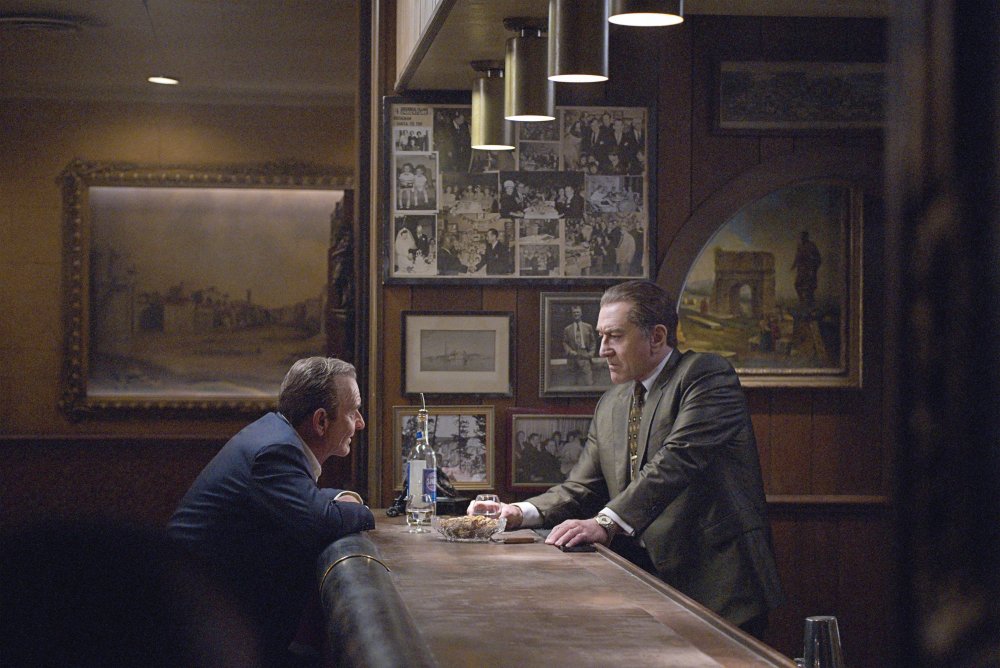
The Irishman (2019)
Do you have a way of describing The Irishman for people who haven’t seen it?
Well, generically it’s in the underworld of the American north-east, organised crime and unions, and the political ramifications thereof, during the 1950s, 60s, 70s. It goes up to about the year 2000, yet it focuses on one character, Frank Sheeran, who is a devoted member of this so-called dark society. It’s a story of a man who finds himself in a position that he hadn’t expected, and it’s based on love, duty, loyalty and, ultimately, betrayal.
We tried to make a film that is on a big canvas, but focuses down to one person, and stays with that person until the very end – really the end of their life. People come and go, governments come and go, strange things happen, people find themselves being used as pawns – not to ask any questions and just be a good soldier and go out and do what you’re told to do. And the ramifications thereof no one talks about.
It’s really a moral conflict – a film about how Frank balances what he is as a human being with what he does in his life, which ultimately overwhelms him. And it has some very funny moments too! [Laughs]
Is it true that Robert De Niro found Charles Brandt’s book I Heard You Paint Houses when he was doing background research for something else, and brought it to you?
[Screenwriter] Eric Roth gave him the book. We had wanted to make a film together: we hadn’t since Casino in 1995. Over the years we tried various projects. I would always check with him what he was doing and vice versa – and we just never connected on what he wanted to do and what I wanted to do.
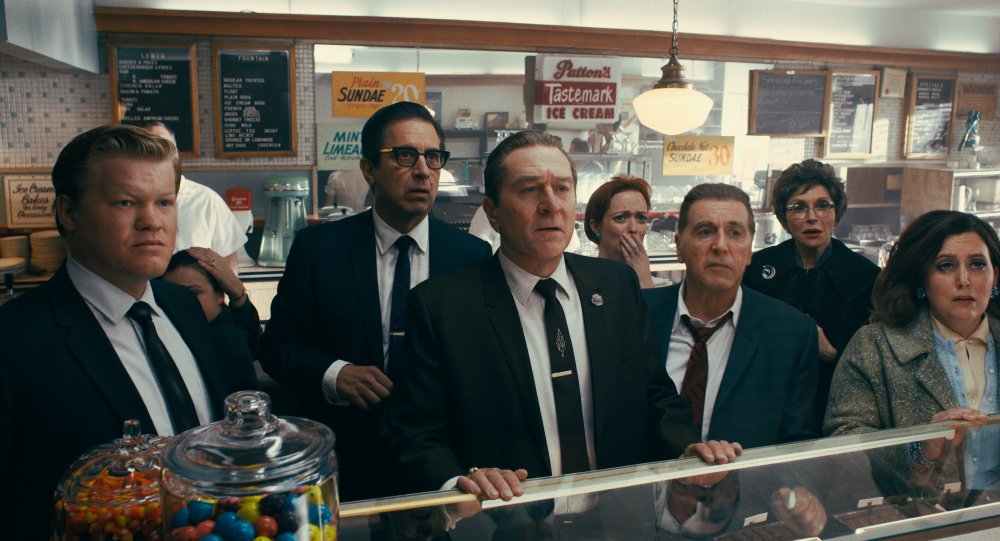
The Irishman (2019)
And then finally he admitted to me, “I’d rather, with the time we have left, revisit that world that we feel very comfortable in.” I said, “Well, all right, but there are so many stories out there, the genre has become saturated – so what’s new in that?” And then Eric Roth gave him this book.
We had been playing around with another project called Frankie Machine [based on the novel The Winter of Frankie Machine by Don Winslow], and that was a good example of something, ultimately, that I realised I cannot do. I tried. It’s a mixture of a genre – I just feel like I don’t want to do genre, meaning a real genre of… I guess the extension of the B film or noirish film in today’s marketplace. And the very fact of the place and genre limits us, and I couldn’t find where to go with that character – in this configuration, in this story.
We had a deal actually, at Paramount Pictures. [The late Paramount head] Brad Grey said, “I’ll give you a green light, and on the phone Bob said, “Actually, we’ve found this other book.” And he said, “Well…”
Now I knew what he had in mind, Bob, because when he presented the idea to me – and I hadn’t read the book yet – he became rather emotional, and I realised that’s the key. If I could feel the same way, or create something that allows me to get to that emotional state, creatively, that might be the way to go.
So I had that conviction. I knew it. So when Bob said to Brad Grey on the phone, “I think we have another project, we found this book,” Brad Grey says, “Let me get this straight. You wanna switch from a greenlighted movie to a development deal?” And we said, “Er, yes!” [Laughs]
You were both busy with other projects at the time?
Bob was making other films. I was making, I guess, The Departed [2006], and then Shutter Island [2009], things like that, so I was working. I was trying to get Silence made, really – and so that also pushed this picture back. So when I finally did Silence, that was when we realised we could not have Bob play younger any more. And that’s when Pablo [Helman, of ILM] came to me on the set of Silence and said, “We can do this with youthification.”
But I skipped a very important point, which is that immediately they’d made the deal, I hired Steve Zaillian. And he put the script together. And once I saw the script, I knew we had something. I realised the kind of picture it would be. What I wanted to do was seeping in.
I told Bob. He didn’t ask me to explain it. He knew that I felt something. I said, “It has to be done a certain way, and I’ve got it. I know.” And [that way meant] eliminating as best I can the complications of major production…
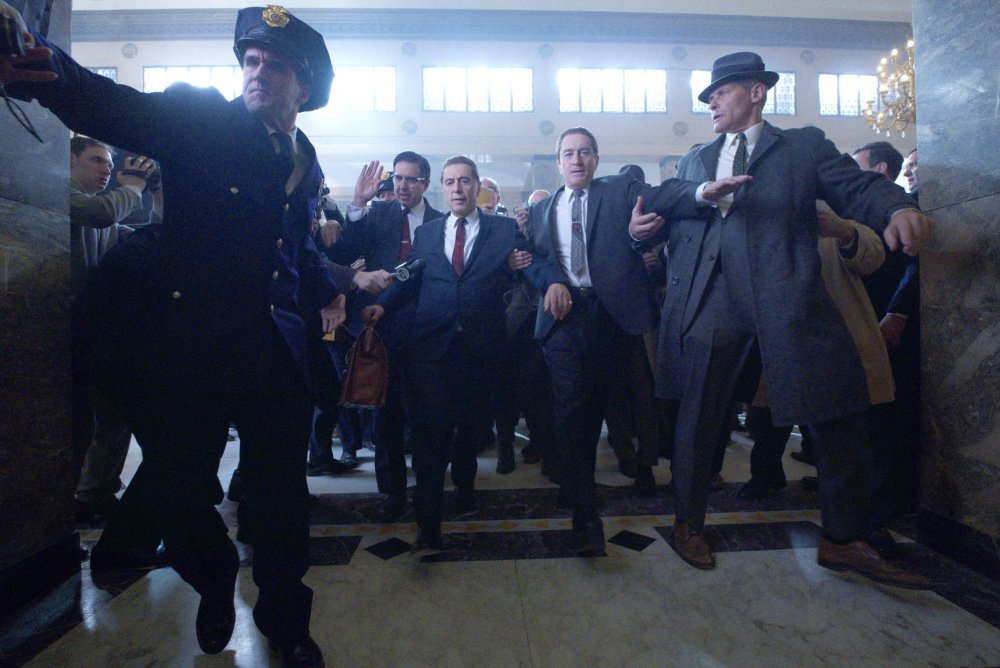
The Irishman (2019)
Credit: Courtesy of Netflix
Now, eliminating certain elements like that, we created other complications with the CGI. But there was a trade-off. We could concentrate there, get to the heart and soul of the movie, rather than an overcomplicated, unnecessary situation where you’re dressing three city blocks or going to actually shoot in Pittsburgh and places like that. All this action takes place in a closet, basically. So I knew at that point the sort of picture it had to be. It had to really rely on the interplay of the characters, the actors.
Brandt’s book is great, but perhaps – given that he is a lawyer – it goes in all sorts of directions. It must have been hard to adapt?
There are so many wonderful things in the book, but I had to get it down to him [Frank Sheeran], to find my way with him, not Charles Brandt’s. And also the tone of the voiceover… that’s why we went back to some of the audiotapes, to get the actual language. Somehow these were… it’s good, but it is… from the point of view of an interrogator. We need to go from the other point of view. And we have to stumble our way through that.
Did Steve Zaillian go off and do the script more or less on his own?
Oh no, we were here [in this hotel room]. We used these rooms, and we talked, primarily about the road trip.
So was the road trip the film keeps returning to, with Frank and Russell and their wives driving to the wedding in Detroit in 1975, always there as a structuring element, punctuating the narrative?
Always there. To the wedding, which isn’t really a wedding. And Frank thinking it’s the road trip: we’re just driving along; we talk about the past a little bit… Then it was a matter of choosing significant moments rather than spectacular scenes. I mean moments in their lives or how they behave.
For example, to show just a little about the bond between husband and wife in that world, the scene when Pesci comes back at night covered in blood. You don’t have to explain anything, you don’t have to say anything. She just says, “I’ll clean it up.” That’s not in the book, but it’s real, and when you have that kind of complicity and trust, that loyalty, that’s the world you’re in. You just are.

The Irishman (2019)
Zaillian and I went through it a number of times. Then I wanted him to layer in more of Anna Paquin’s character, [Frank’s daughter] Peggy. I didn’t want any dialogue. So he said, “How are we going to do that?” Of course, we’ll do the scene at the beginning when she’s a kid [when Frank beats up a grocer] – that certainly leaves an impression on her.
And then I insisted on going back and layering in Peggy more, to be an observer… not an observer, but she’s part of the group, part of the story. She knows Frank. She doesn’t have to say a word. When she’s looking at him and he’s sitting eating his cereal, listening to the report [about the death of Joey Gallo] – “A lone gunman walked in.” The look on his face – it’s him, obviously.
Now, whether he really killed Joey Gallo or not, or whether he killed Hoffa… I’m not interested, it’s a matter of the moral choices that he has to make, that he’s forced to live in, that all the people around him are affected by, in his life.
And we also layered in Chuckie, the adopted son [of Jimmy Hoffa played by Jesse Plemmons] as much as possible. I even think I was doing some of that while we were shooting, adding characters to certain scenes, to try to keep a balance going on in this giant fresco.
☞ Danny DeVito’s Hoffa is a rare Hollywood left turn
Particularly towards the end, it feels as if you’re going from the crime film with the plots in which people are in danger of being killed, to a film that’s more just about life. For example, there’s a moment late on when Frank hears that his lawyer is dead and asks, “Who did it?” – and the FBI man answers, “Cancer.”
That’s the first thing that comes to mind, if you’re in that world. It doesn’t mean that the FBI have to know about it. It’s just, like, “Wait a minute… Oh, no, it was natural causes, OK.”
They’re in that world, and it’s convenient to say that it’s not very different from the – how should I put it? – the establishment. It’s not very different. It’s all about power. There’s power here – but ultimately, it’s about love. How he has to deal with what he’s feeling and what he’s obliged to do, and then how he deals with himself afterwards.
And the different steps of dying off: all the old men dying off, his family dying off – or being lost to him, his daughter [Peggy] particularly, Anna Paquin who’s terrific in the film, she only has one line of dialogue. But that one daughter knows, she knows everything, just with looks – and that’s the one he wants to be with, that’s the one he wants to love him [but she refuses to speak to him after learning of his crimes] – and he tries to explain all these things to his other daughter.
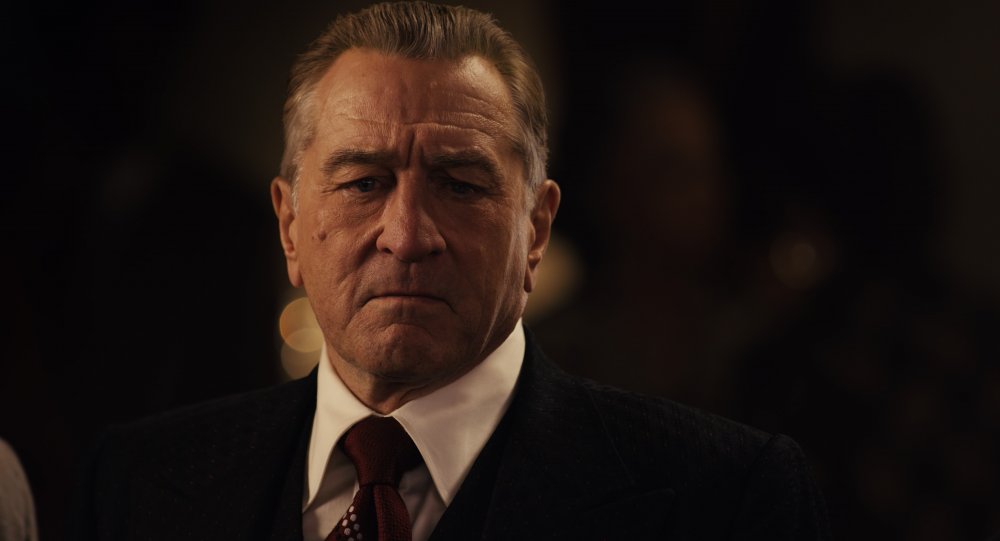
The Irishman (2019)
And he’s right, there were bad people out there. Fighting your way up the boot of Italy, if you survive for 411 days of combat, it does something to a person. I’m not saying it’s an excuse, but… when he talks about “You don’t know what’s out there,” they don’t. [Laughs] It doesn’t mean he has to behave the way he did. But they simply don’t.
You feel sorry for Frank because of his experiences in the war. If you didn’t see the kind of thing that he had to do in the war you would feel differently. It sort of sets everything else up.
It really does. But there’s an oversimplification: “He’s this way because of the war.” Not necessarily the case: a lot of people came back, didn’t do what he did. He just has that in him as part of his human condition, he’s prone to it, and he gives in to it.
But the fact that he feels slightly uncomfortable killing the unarmed men [as we see in flashback] – and he has that line, it’s in the book, where he says, “Maybe they dug their own graves, I can’t understand how they kept doing that. Maybe they thought that if they did a good job the guy with the gun would change his mind.” And then immediately: shoot. [Snaps fingers] He didn’t change his mind. It’s terrifying.
So there’s that humanity in him that goes against it, and he’s struggling with that – he comes out, but he winds up in the same world. It’s like he’s forced to do what he does.
That’s not an excuse, it’s the world he’s in. He can pick up and move out… What other milieu is he going to find himself in? Truck drivers in one place, truck drivers in another place. Mafia here, organised crime there. Wherever. He’s on a certain level, he’s not going to go and suddenly start reading Middlemarch. I’m sorry. He’s not going to take comparative literature in college. He’s stuck with his life.
When Frank says the Mafia boss Russell Bufalino “took a shine to me”, it’s immediately after he’s said that he’s had all these days of combat. Russell knows Frank’s a thief, he’s not denounced his confederates so he isn’t a rat, and he knows how to follow orders.
Yes, he’s a big man, a tough man, he can be brutal – but he’s efficient. If you notice, the killings in the film are executions, they’re not spectacular in any way. I guess the Umberto’s Clam House killing [of Joey Gallo] is spectacular, but it’s very efficient, very quick.
And Frank talks about the philosophy thereof, of each hit. In this case, “Don’t shoot the bodyguard, Pete the Greek – well, don’t shoot him to kill him.” It’s his job. He’s a bodyguard, we’re all professionals – just the leg or the arm, that sort of thing – and get in and get out fast.
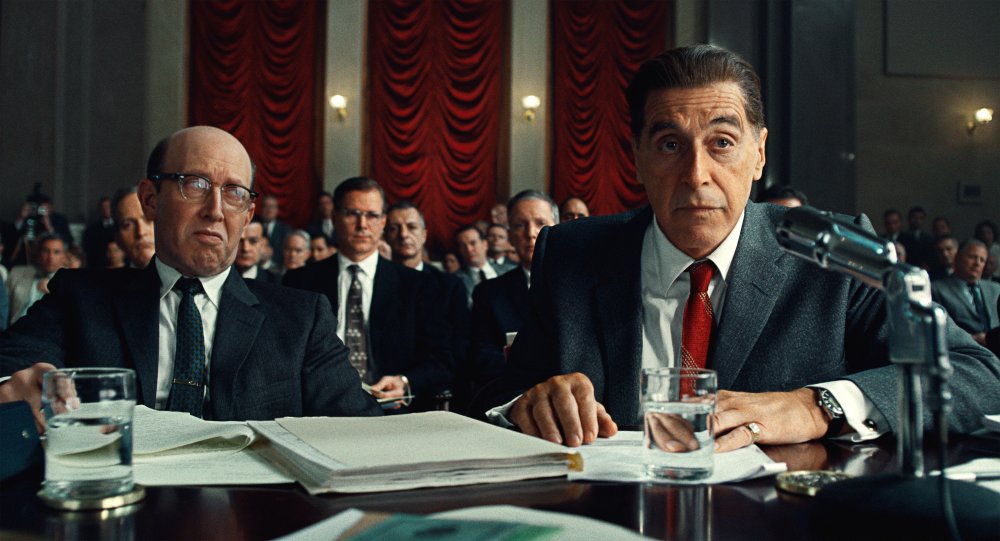
The Irishman (2019)
It’s striking how high up he is, to do that. You wouldn’t expect the president of a union local to be doing these things.
Yes. The more I read, the more the tentacles go out to areas that I don’t really want to know about any more. But the game is played, and that’s how it happens. There are always the real ‘higher-ups’. It’s just the nature of power. And organised power. Everybody’s doing well. You have to behave. And if you don’t… You know, we have ways of dealing with it. And that’s it.
The film touches on huge political matters – the Kennedys, Cuba, JFK’s assassination – but keeps at a distance from them.
The whole thing about [Mafia involvement in] Dallas itself is something else. I don’t even get into that. The conspiracy theories are always compelling and entertaining. But I’ve got to say, I do believe there are elements that are absolutely true. Whether that was the final cog in the wheel, I don’t know. But they’re fooling around with some bad people.
In The Irishman, the violence is portrayed differently to the way it is in GoodFellas, and things like The Sopranos where they’re all fans of GoodFellas and so on, isn’t it? Partly the role of Peggy is about that. You can’t simply enjoy the violence. Here the moral cost is being counted as the violence is experienced.
Yes, exactly. I think that’s what I was struggling to get to, without verbalising it. To live a life like that – you pay, they all pay. Everybody around him and her, they all pay. And so it’s not a glamorous life, it really isn’t. And yes, there are elements of humour – a dark humour so to speak is certainly there – but this picture goes another way…
I think I only saw one episode of The Sopranos, for example, because I can’t identify with that generation of the underworld. They live in New Jersey with the big houses? I don’t get it. They use language – four-letter words – in front of their daughters, at the dinner table? I don’t get that. I just didn’t grow up that way.
The language of The Irishman, a lot of which is taken from the book, is so euphemistic – “Taking care of that particular matter.” These people don’t want to incriminate themselves; they’re issuing orders all the time.
It’s cold-blooded. Russell Bufalino’s known as the Quiet Don. I’d never heard of him before reading the book. He was a very, very powerful man.
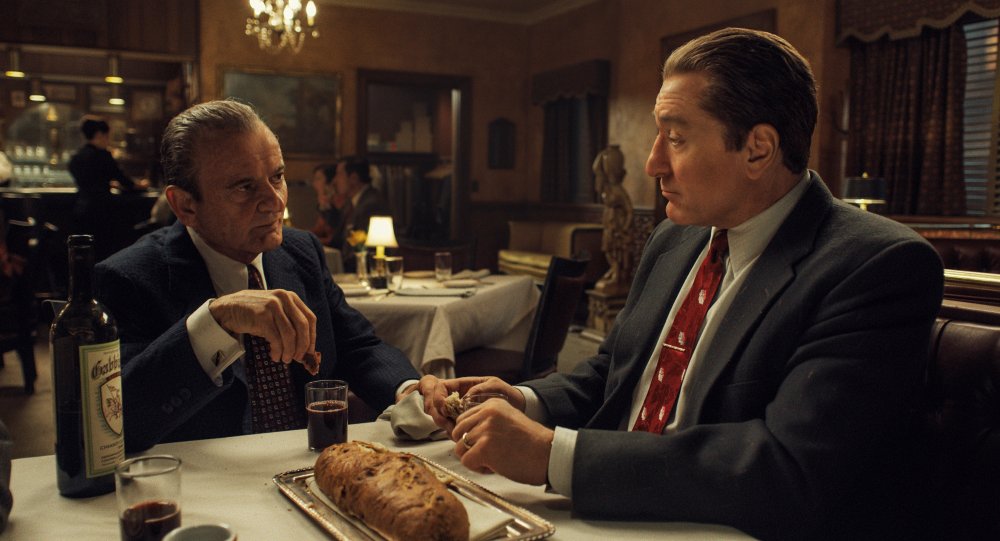
The Irishman (2019)
The euphemism is such that when Frank has to tell Jimmy Hoffa that “it is what it is” [ie, he will be killed if he doesn’t compromise], Jimmy won’t accept it. And he goes further, and finally Frank says, “This is it. It’s the bottom line.” He won’t say it. He can’t. “This is it. It’s it!” “Well, I’d better get bodyguards.” “Don’t get bodyguards.”
And they’re back and forth, but: “How many times do I have to tell you, looking you in the eye, and telling you, ‘It’s over. It’s over.’” And then his reaction is, “They wouldn’t dare.” There’s no need to say certain things, there just isn’t. That’s what’s so… I guess cold-blooded is the word, but it’s efficient.
The use of In the Still of the Night by The Five Satins on the soundtrack, framing the film, is wonderful – it could be about the Mafia, or it could be about God, or the family.
Exactly. [It goes back to] the Catholic preaching I used to hear back in 1950, 1951: “Like a thief in the night, Death will come” – and ‘the still of the night’ is when it happens. So this is always something in my head. Now we’re there – at a certain age. The still of the night: it’s clandestine, it’s love, danger, everything.
And that’s the quintessential song of that type. For that time, you know. It’s simple – and kind of moving. It created an atmosphere and a mood when that came out. You would hear it on jukeboxes, radios. And so… that was the movie, that song.
About the use of ‘youthification’ in the film. You were quoted as saying at an earlier stage, when I think you weren’t happy with the first version, “Does it change the eyes at all?”
That’s the second time I’ve heard that as if it was a negative thing. Actually not. What I was saying was: “That’s the job, that’s what we have to do.” In other words, you keep the eyes, but even if you keep the eyes, there’s much more to that: there’s the crow’s feet, there’s the bags under the eyes, there’s the eyebrow. There’s the way the light hit. So every frame you see, there’s infinitesimal work that’s been done. Ultimately, it’s about the performance and about the character.
I knew the sort of picture it has to be. I said, “I can’t have the actors, these actors, with mechanical objects on their heads” because they’re not going to do it, it gets in the way.
But then Pablo [Helman, the film’s visual effects supervisor] came back to me and said, “I think I’ve figured a way.” And he made the… I guess they’re called contacts; little pieces of fabric or something that really were invisible. And you know, you could be wearing it like, round here [indicates his face], and at a certain point you’re talking to a person, you’re not talking to a machine.
The challenge, as they say these days, was to take those elements and keep the person, not lose them in something that is cleaned up. It’s really about keeping that character, keeping those emotions and their faces alive.
In one scene where De Niro’s younger, for example, and he’s talking to some people and he has to convey a kind of vulnerability and a haplessness – making him younger, a couple of times we noticed, made him look like he was threatening them. Now why’s that? The line around the mouth. So, let’s go into the mouth, work on that.
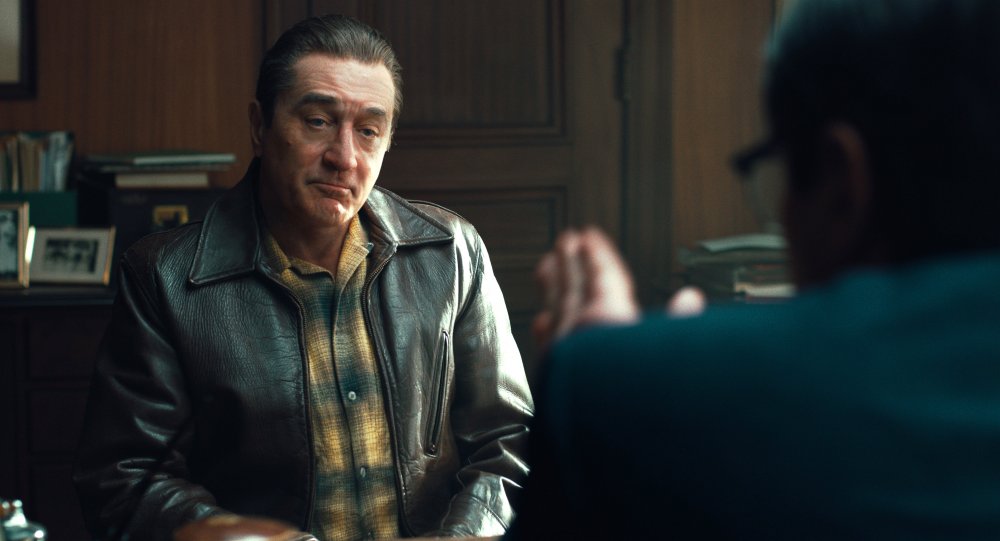
The Irishman (2019)
A week later they bring it back. “No, it still looks like he’s threatening.” Well, maybe the eyes have to be fixed – around the eyes.
I’m going for what the performance is. Ultimately, we felt that we regained through the youthification process the vulnerability in that moment.
So it makes you look very closely at the actual way that facial expressions work?
Yes, at every aspect of the face. And then of course as the actor moves in the frame, the light changes. So a few frames this way – you’ve got to put some texture here… and so you’re really creating, recreating, the performance, in a way, with the basic truthful elements of the actor, and protecting those.
We stumbled through that. We said, “What about trying this? What about that?” It would come back a week later, we would say, “It looks a bit funny here, or there.” And so we’d go back. We did that with every shot, with Joe Pesci and with Al too. It’s a learning experience.
In a way, I look at it as… well, there’s the convention in cinema of the use of make-up. If you look at an older film, there was an acceptance by the audience where the hair is powdered, or you know that that’s makeup and that the moustache is fake. But you went with the illusion.
I always remember the great Dick Smith, and the old-age make-up he made for [Dustin Hoffman’s 121-year-old character in] Little Big Man [1970]. Or the make-up in The Elephant Man [1980]. Where’s the heart? Where’s the performance? It’s there, because John Hurt was great. But I know that’s make-up, so as a viewer I go with the illusion. I give you something back so I can get something from the world that you’re trying to depict for me and the characters.
It’s another level of that, I think. And ultimately, it might be superior in the long run, to creating an illusion. Rather than having to apply prosthetics and that sort of thing. Mind you, we did a great deal of make-up on the film too.
Do you think this system will have an effect on other films that are made?
I think so. Obviously, it may have an effect on films that are trying to create more of a futuristic world. But it’s as good as the people doing it, really. Pablo and his group and ILM were amazing; and we were – myself and Thelma – on them to work in the slightest, the most scrupulous way.
One of the key things was, I didn’t want to make a film dealing with this subject-matter, and this character – and where we were taking him, to the very end – and have half the film working with younger actors that were supposed to be Bob, supposed to be Joe, and supposed to be Al. I just didn’t.
And so you may find that now that’s something that is doable: actors playing themselves younger – or older. This is a first time and there is an element of cost. But I think the more it’s used, the more the cost will become reasonable.
De Niro’s performance is wonderful. Was he involved in the script?
Yeah, once he’d read it he had questions, and then we made some changes as we were shooting too. But we just found our own way really.
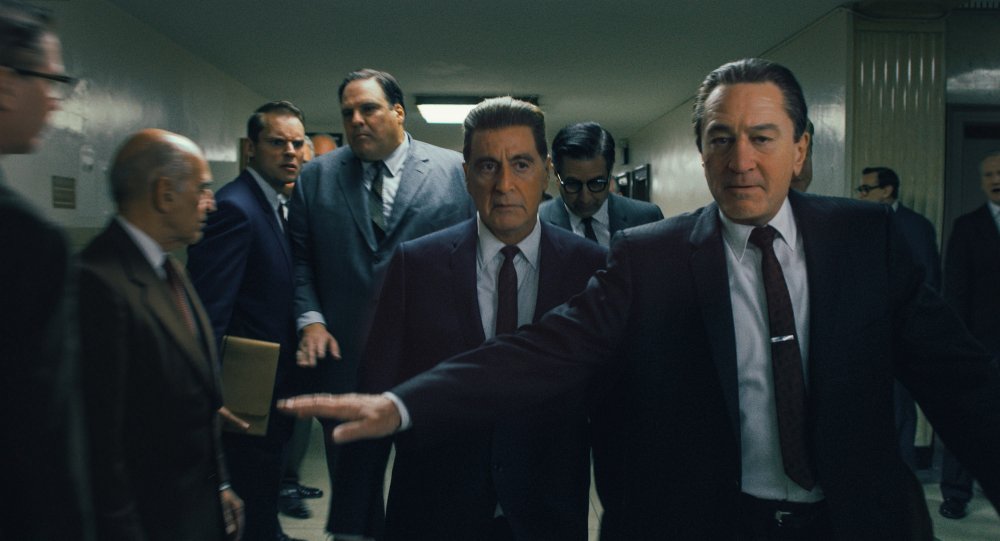
The Irishman (2019)
Al Pacino was the new actor for you. He came into the production after some of the others. I read that he was slightly nervous joining the team.
I guess he was, but we didn’t really rehearse or anything, we just would talk.
I go back with Al. Francis Coppola introduced me to him the first time in 1970. Francis had come to my mother and father’s apartment on the Lower East Side and we’d be eating dinner, and I became friends with him that year. Francis was telling my mother about The Godfather [1972] and how he was casting it but the studio didn’t want who he was casting. “They didn’t want Marlon Brando” and “I may have to do a screen test, but I can’t tell Marlon it’s a screen test.”
All this was going on, and then he said, “And then I have this new actor to play Michael,” and he told my mother, “He’s named Al Pacino and he looks just like your son. He’s a terrific actor but he’s never done a film before and they don’t want him.” And he said, “What am I going to do with these people?”And he said, “I’m gonna take you to the Village.” And he took me to Greenwich Village, and I saw this play by Israel Horovitz called Rats, which was really interesting, and it was directed by Al. That’s when I first met Al, that night.
And then later on, Al, after Godfather, was in a different situation, of course, and I think I met him for Serpico [1973]. We talked, but they were on another level of production, it was like him and Dustin Hoffman – they were up, in a way, and we were still scrabbling in the streets in a sense.
So you were considering directing Serpico?
No, they were considering me! Thankfully, I didn’t get it: it’s a Sidney Lumet thing, and he handled it beautifully. I wouldn’t understand… I couldn’t… No, there were a lot of meetings that I… I was considered for but found that I couldn’t fit in. Then he started working with Brian De Palma a lot, but over the years he was always very good with me, respectful.
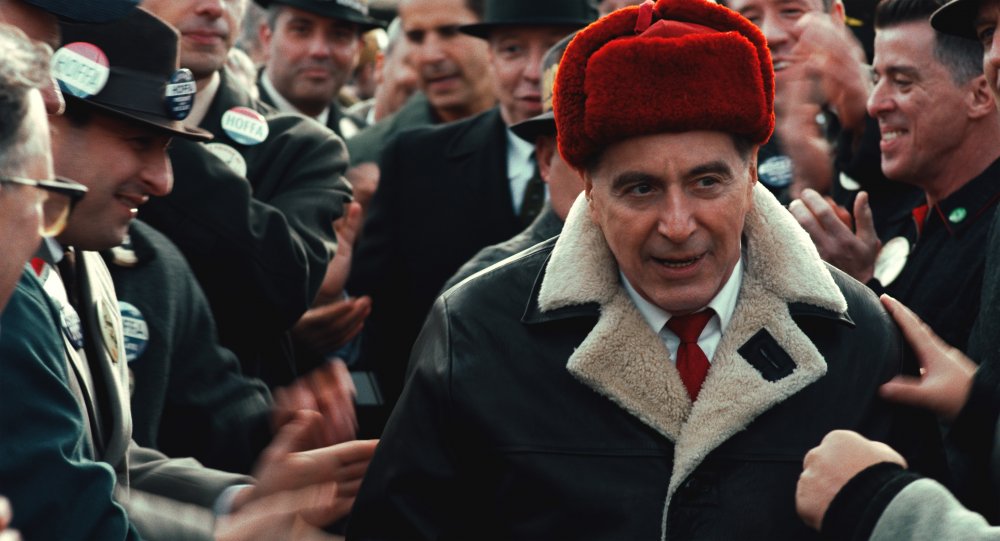
The Irishman (2019)
We tried to work on a project one time in the 90s, on Modigliani, but we unfortunately never got it made. Or maybe in the late 80s. At that time I really couldn’t get anything made. Nothing.
Pacino’s performance in The Insider is very precisely judged in the way that he’s so angry – and he’s pretty much of a raging bull in certain ways – but then there are also these very tender moments…
Yes. I think a lot of it has to do with… that’s Al’s personality. There’s a relationship between him and Bob that goes on for years, and that’s what was tapped into. I don’t know if the actual Frank Sheeran and Jimmy Hoffa were that way, but I do know from the book and from what I’ve read, that they were close. And they trusted each other. He was a confidant, so to speak, from what I can tell.
The film is a sort of reunion of lots of actors you’d worked with before, including Barry Primus from Boxcar Bertha [1972], which is a film about unions, isn’t it?
That’s right, it is: about the famous labour organiser Big Bill Shelley [played by David Carradine].
I very much enjoyed Ray Romano’s performance [as Bill Bufalino, the attorney who represented the Teamsters and worked closely with Hoffa].
When he read for me for Vinyl [the 2016 TV series about the 1970s New York music scene], the guy was great. They said, “Well, he’s known from TV.” I said, “Well, I know, but I never really watched the show, and I didn’t realise.”
But he is spot-on every time. Everything he does is within the character. No, Ray Romano is a wonderful actor – in there with Al Pacino and Bob, and hanging in there. Whatever they threw around, he picked up.
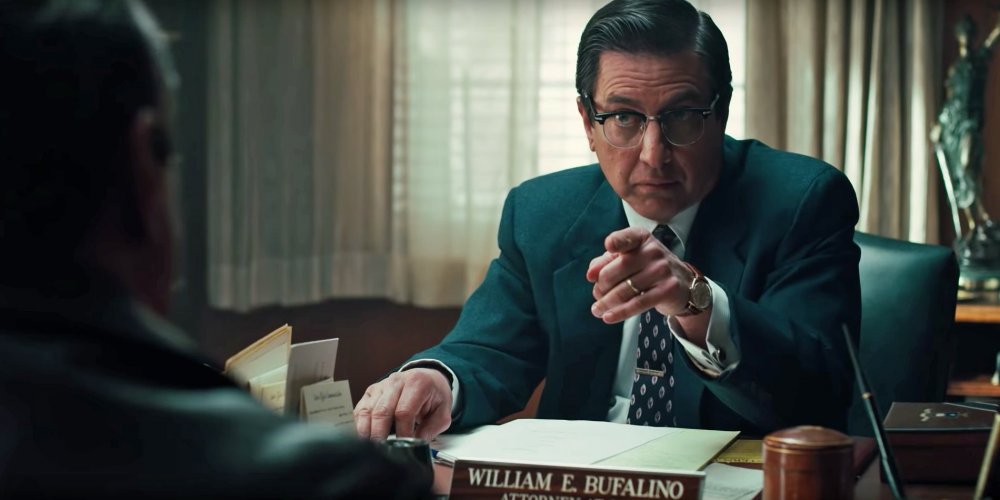
The Irishman (2019)
You seem to have found Netflix to have been very good to work with.
For me they were excellent to work with.
And it’s a very long film.
Yes, it is. Again I took advantage of the venue. I tried doing long-form television – but in order to really do that right you’d have to be doing every episode, almost every season.
And so here I was just trying to experiment with form. And I know that people might be more amenable to spending time watching a film that’s not a series, and so… I came to terms with the nature of the story itself and how I wanted to do it and how I felt I should do it. If I felt I could add something here, that would change this last section, we had really no sense of people coming in and saying, “Cut 15 minutes out of it.” Which is… my life…
Historically, that’s because they wanted theatrical releases, and long films would interfere with schedules?
That’s right. That’s been a struggle and a fight, a war in a sense. So now we just said, “What happens if I just push it here, a little bit? Now if I could sustain the interest, that’s interesting.”
So that’s how I pushed the construction of the film. They were very good with me on that, they gave us all the financial support we needed, and so that was the way this film had to be made. We could not get it made otherwise.
Ideally, I like films in theatres. But on the other hand, we tried to get this film made [through other studios] – it was the other aspect of those nine years when Steve wrote the script and we were trying all these different things and I wanted to do Silence – but nobody would give us the money. I’m not talking about an elaborate budget, I’m talking about a decent budget.
Believe me: at this point in time, in my life, in Bob’s life, the way the picture had to be made, not even the CGI – they still wouldn’t give us the money. We can move fast. On the other hand, we may need to take a little time here and there. You know? And we’ve fought over the years to get that time. And the rug was pulled out from under us, really. They don’t care. Because the way that the Hollywood studios are now… it doesn’t exist any more, so we lost out that way.
And Netflix stepped up. I thought, “Well, at least it can be shown in a theatre for a week or two. And maybe at a film festival, and maybe at some point it can be shown in theatres in a retrospective of some kind.” You know, it will exist. So that’s the way it transpired.
The mode of storytelling you use in the film is suited to the medium. I was thinking about David Simon talking about The Wire and saying that he wanted the audience to be “leaning in” to it – that he wasn’t explaining things, that you were immersed in this incomprehensible world, and you had to make sense of it…
Exactly. To see if you could join that world. As an audience. And go with that, let them take you, rather than us leading you.
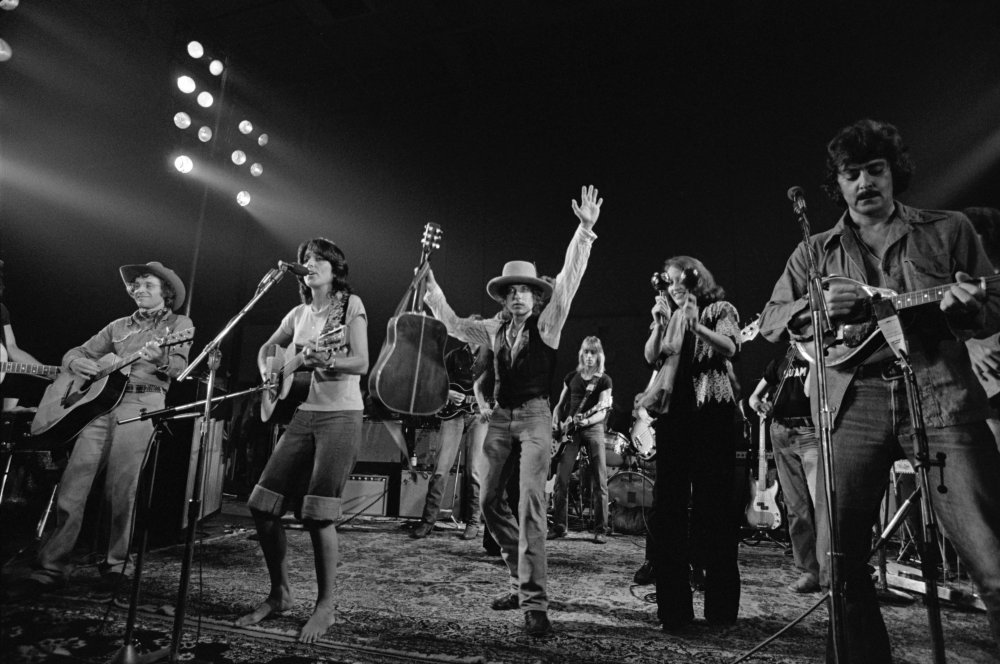
Rolling Thunder Revue: A Bob Dylan Story by Martin Scorsese (2019)
The partly fictionalised Dylan documentary you did earlier this year – Rolling Thunder Revue: A Bob Dylan Story by Martin Scorsese, which was absolutely thrilling, has some parallels with The Irishman. Partly it’s the period – there’s a lot of focus on that particular moment, because it’s the 70s: 1975-76.
It did influence the structure of The Irishman. Because once we had Rolling Thunder constructed, [editor] David Tedeschi and I looked at it, and I said, “It’s conventional. It’s just a film about a group of people who go on the road and they sing some songs. I’m going to have to start all over.”
We have to go with the music, maybe, go with the spirit of the commedia dell’arte. And then the words started to come in about possibly people who weren’t there, being there. [Laughs] That’s interesting. That’s a challenge, as they say. Let’s pursue that.
Let’s say Sharon Stone represents certain things. What about the businessman, the marketing man? And that’s [the head of Paramount] Jim Gianopulos. And Irwin Winkler [producer of Raging Bull], my old friend, they started Chartoff-Winkler, they were agents for famous musicians in the 60s.
So why don’t we not stop there? What about the filmmaker? Great. And he had to be taken advantage of. [Laughs] He possesses the performers, he wants to be them. It’s like us, making this… we love the music and the performers so much that the only thing we can do is photograph them and edit it, right? And we wanna be them. And no matter what, we’re left wanting more.
So that fed into The Irishman?
Well, yeah. Let me put it this way: something that I’ve been working on over the years is with narrative. On certain films I’m locked into a narrative – I used to say plot, but it’s more than plot, it’s narrative. But I’ve been trying to break free of it, and tell stories in a different way, and I found that the documentaries helped me with that.
Rolling Thunder; the George Harrison one, Living in the Material World [2011]; Public Speaking [2010], about [author] Fran Lebowitz. They helped me go by tone – where the inspiration comes from takes us to another story, or to another place – and it’s more spatial than time.
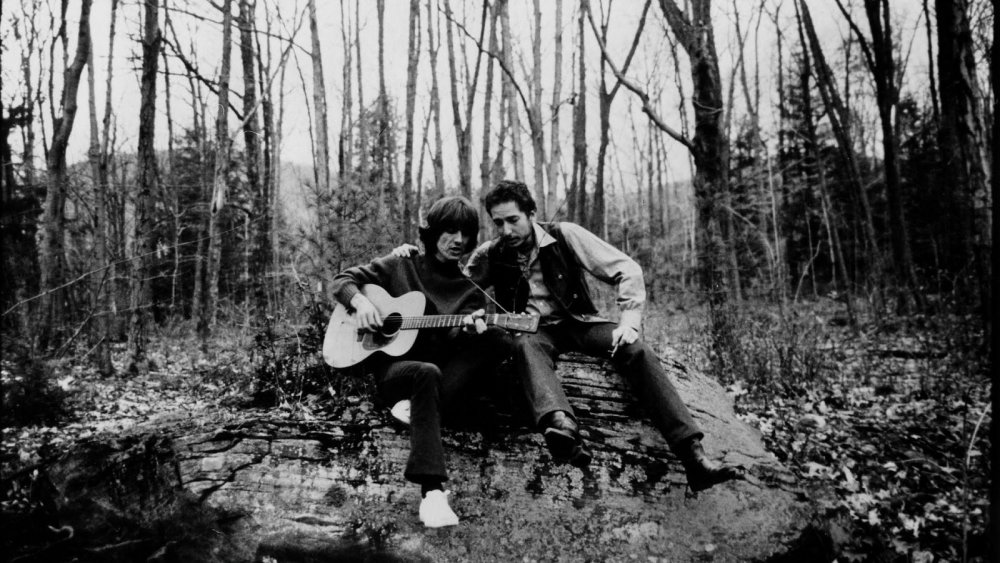
George Harrison: Living in the Material World (2011)
Is this new approach about trusting intuitive connections more than you perhaps had done in the past?
Yes. Totally. Intuitive connections. Almost improvisatory… And then structuring that somehow. Finding where that takes us – and how you feel at a certain point, or what you’re thinking, and then pull it back here. And shock and then move again and take off, fly off at some other beautiful piece of music or something or, you know, some wonderful monologues.
Do you hear back from Dylan?
No. I’m good friends with his producer and archivist Jeff Rosen, and Jeff is the one. Last time I saw Dylan was at a big dinner for Armani, 20 years ago. I met him a few times with Robbie Robertson. That’s about it.
But I do enjoy doing the films. They’re almost impossible, and it’s like working out, in a way, creatively, in that it’s not a matter of making the story of a tour. Who cares? It’s capturing a time and place. Even little things like when Allen Ginsberg is talking about poetry – and that you don’t have to use a [fancy] phrase like “diamond fairies dancing” or something, just listen to the room [instead]… listen to… maybe there’s a sound, even the sound of your pencil or pen on the paper. There’s the poetry there.
I mean, naturally, one could argue against that, but it makes you think another way. And so that’s fascinating to me.
In The Irishman – and in Silence too – you use little mini-dissolves within a scene. That’s because there are bits of two different takes that you wanted?
Yeah. Just pragmatic. But it works.
It’s a technique from documentary, isn’t it? You notice, but you don’t mind.
Exactly, and that’s what I was trying to get to. I enjoy doing that now particularly from the documentaries. Sometimes you find yourself unnecessarily locked into a form: “Oh, you can’t go from here to there.” Well, you know what? Let’s just do it. And we’ll know if it’s disruptive. We’ll feel it. Let’s break the form.
Really, this film is pretty straightforward in that way, but – well, it’s all throughout the picture, too, there are moments like that. I’ve been trying to fight that form and “It isn’t done that way!” Well, maybe it should be.
Thinking again of Silence, the shot of Hoffa’s body being cremated, where he’s got the gun beside him, reminded me that there’s the cross on Rodrigues’s body as he is cremated in Silence…
Yes, that, and it’s very close to what Dylan says at the end of Rolling Thunder, which I disagree with in a way, but he says “What’s left of this tour? Nothing, dust, ashes.” And then we punch into Knockin’ on Heaven’s Door.
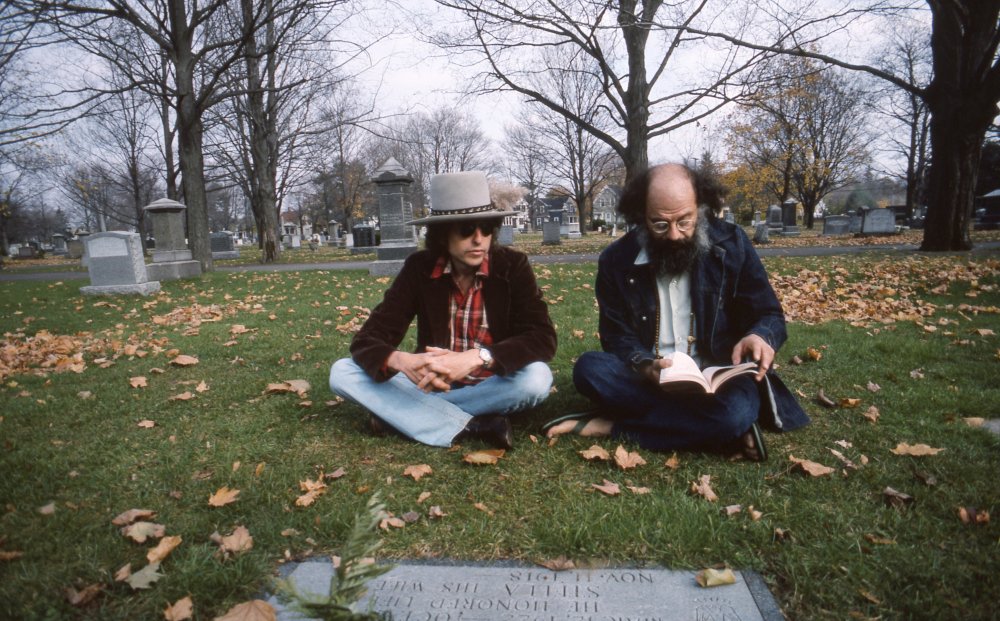
Rolling Thunder Revue: A Bob Dylan Story by Martin Scorsese (2019)
And we end with Allen Ginsberg, with the spirit of the whole tour, and his wonderful monologue at the end, and so it kind of refutes what Dylan says – but in his mind, from what I understand, he felt that those elements that put together that tour, and those 70s, will never happen again. It’ll happen in different ways, maybe, but for a different society and a different way of thinking – I don’t know, a different world.
He used the word ‘ashes’, and so I was always reminded of the church of the Capuchin monks in Rome, where the head of the order in the 17th century, Cardinal [Antonio] Barberini, has his tombstone on the side of the church, and it says: “Here lies dust, ashes and nothing.” And I saw that 40 years ago and I’ve never forgotten it. And the Dylan thing reminds me of that and here, the cremation. And the passage into wherever it is. Oblivion.
But my feeling watching the Rolling Thunder film was that it was thrilling, these possibilities, it’s exciting…
It really was. He can say that about his perception of it. But the point is to let younger people know there was a time when such a thing could be. Just for the value of itself. Not necessarily the big arena, and the money and the ads and the iPhones, and all that. There was a time when just the purity of this form was able to express itself that way. “Go out and make it for your own eternity” – that is what Allen Ginsberg says.
Actually, I had to make a speech for my daughter’s school graduating class two years ago, and I ended with that, “Go and make it for your own eternity.” How beautiful you are, how beautiful your friends are, just go and do it for yourself, for your own eternity. And I think that supersedes whatever feelings he may have had, or has, about this quote unquote ‘tour’.
Maybe I’m romanticising it – but there was a purity in it, I think. Because it was a reaction against, I think, the Before the Flood album with The Band, going on tour, with the big arenas, and that sort of thing. That’s where rock and roll was going, but… [Dylan said] let’s go back the other way now, let’s go back to the essentials.
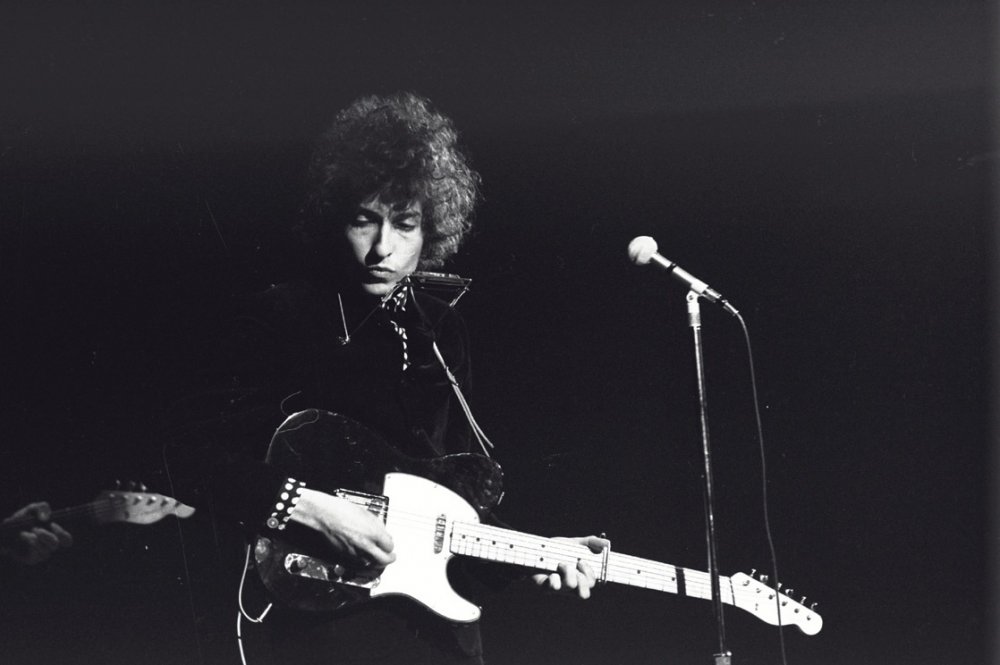
No Direction Home: Bob Dylan (2005)
So in a way it’s like your earlier Dylan documentary, No Direction Home [2005], which is so stirring about the way he’s refusing all that stuff being loaded on to him.
Yes, exactly. Reinventing yourself, and ‘making it for your own eternity’. Just try to stay as best you can with the elements you choose to work with, or the world you choose to work in, try to remain as true to yourself as possible. Whoever you are. [Laughs]
It’s all searching anyway, and so if you choose to go a certain way, there are certain elements that you can deal with. And that means, in terms of film, many different venues, now especially.
I’m thinking about Agnès Varda. She used the tools, and if the tools became a digital camera that she could just point and shoot, that’s what she used. Whether I prefer seeing a film in a theatre or not, the point is that for the artist, or for a person who’s trying to be an artist, use what’s there, and you can create the venue somehow and get shown.
☞ Agnès Varda obituary: a luminous art of an illuminated life
You’re about to make Killers of the Flower Moon, the story of the Bureau of Investigation handling of the 1920s murders of members of the Osage tribe in Oklahoma, who had become immensely rich through their oil rights. The narrative, in the book it’s based on anyway, is more linear than it is in The Irishman, isn’t it?
Yes, but again, I don’t know if I’d do it that way. I’ve been working with Eric Roth on the script for a few years now, and we’re – now, actually, yesterday, in this room, and last night – we’re knocking away at this script, and restructuring it, rethinking it. Because it’s convenient to do a sort of detective story, but we all know what it is.
So I want to explore something else, and that is the nature of a whole way of thinking as being complicit in genocide. It’s dehumanising people.
I was out in Oklahoma about six weeks ago, and ultimately, as the Osage told me, it’s about greed. And therefore you could think that these people don’t deserve any of it because they’re not human anyway. Not really human.
That opens up a whole interesting situation, let’s say, with William Hale [the jovial, sinister white local patriarch] and his nephew Ernest, and [his Osage niece-by-marriage] Mollie, beyond even the Bureau of Investigation and [its agent] Tom White, who’s a good man, comes in – he couldn’t pin it on anybody, he couldn’t get evidence – they were all doing it. Or they’re all, at least, complicit in sins of omission. They were quiet about it.
And ultimately that’s the story, the whole idea of the status quo being guilty.
De Niro is going to be in it?
[Yes, as] Bill Hale. William Hale. Gotta get him in there. And Leo [DiCaprio], I think playing Ernest at this point, the husband. And we haven’t yet settled on Tom White, but… yeah, it’s shifting the story from – since we know what happens and we know certain characters… Then how do you tell the story from the inside rather than from the exterior in? It’s going to take a few more months to get that right.
But I was in Oklahoma, met with the Osage, Chief Standing Bear and his family, and it’s quite remarkable. I was certainly – how shall I put it? – surprised by the landscape. This is very different. I’m more used to the South-west, California, New Mexico – I did a film there. The landscape here is something that I hadn’t anticipated. The space of it. And the isolation is interesting. I mean, we’re just beginning, but I hope to get there, I hope to start shooting it by March or April.
But it’s exciting, and we’re just grappling now, getting the script together. I have to go around, do some travelling, for The Irishman, but these days it’s best just to get to work.
-
The 100 Greatest Films of All Time 2012
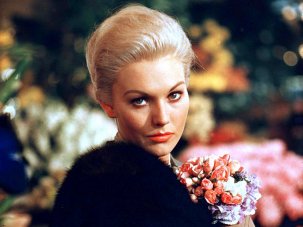
In our biggest ever film critics’ poll, the list of best movies ever made has a new top film, ending the 50-year reign of Citizen Kane.
Wednesday 1 August 2012
-
The best films now on UK streaming services

Looking for the best new cinema releases available on British VOD platforms? Here’s our guide to how to keep up with the latest movies while you’re...
-
The Digital Edition and Archive quick link
Log in here to your digital edition and archive subscription, take a look at the packages on offer and buy a subscription.




